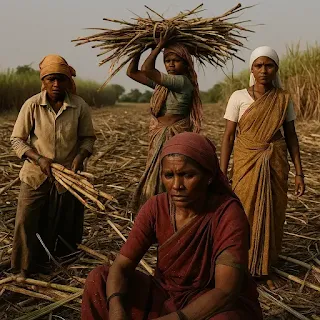Introduction: A Silent Tragedy in Rural India
Imagine a village where more than half the women have lost their wombs by the time they are 25. Not to disease, not to age, but to survive a job that barely pays enough to feed their family. In Maharashtra’s drought-stricken Beed district, this is not fiction it’s daily reality.
“They call us the villages of womb-less women,” says Manda Ugale of Hajipur village, her voice carrying the weight of sorrow and resignation. The practice of mass hysterectomies means (a surgical operation to remove all or part of the uterus) among female sugarcane cutters in Beed is a grim reminder of the gendered exploitation that thrives at the intersection of poverty, patriarchy, and poor governance.
Source: World News Day | Original story by Radheshyam Jadhav, Hindu Business Line
Why Are Women in Beed Undergoing Hysterectomies?
Every year from October to March, thousands of families from Beed migrate to western Maharashtra for cane-cutting season. In this labor-intensive job, the husband and wife are treated as one work unit. If either takes a break even for illness or menstruation they are fined ₹500 per day.
Periods Are Penalized
Menstrual periods are seen as obstacles in this harsh schedule. “We can’t afford to lose even a rupee,” says Satyabhama, a cane cutter. Contractors prefer women without wombs, as they won’t need rest days due to menstruation.
The Inhumane Economics
Let’s break it down:
Couples earn ₹250 for every ton of sugarcane cut.
- In a season, a couple cuts 300+ tonnes, earning roughly ₹75,000 in six months. That’s often the entire year’s income.
- Every missed day is a financial loss, pushing families to choose Hunger over Health.
Doctors or Dealers?
Shockingly, private clinics often perform hysterectomies without valid medical reasons. Women complaining of white discharge or mild abdominal pain are advised surgery often funded by the contractor and later deducted from wages. Many girls as young as 25 years old are undergoing these life-altering procedures.
According to NFHS-5, the national average of hysterectomy among women aged 15–49 is just 3.3%. In Beed’s cane-cutting communities, this number is estimated at 21–36%.
(Source: NFHS-5, 2021; BBC Marathi)
The Toll: Health, Dignity, and Rights
1. Hormonal Havoc
The uterus may be gone, but the problems begin afterward hormonal imbalance, depression, early menopause, and weight gain. Long-term complications include:
Osteoporosis
-
Urinary incontinence
-
Cardiovascular issues
2. Psychological Trauma
These surgeries often occur without informed consent or understanding of the side effects. Many women report anxiety, loss of identity, and a sense of betrayal by the system.
3. Social & Sexual Exploitation
In makeshift camps near cane fields, basic facilities like toilets and privacy are missing. Older women like Vilabai whisper about the sexual exploitation women face during migration season.
"Periods are not just biological; they are a symbol of dignity and autonomy. In Beed, that dignity is systematically taken away." Achyut Borgaonkar, Tathapi Trust
Root Causes: A Vicious Web
| Cause | Explanation |
|---|---|
| Drought and migration | Beed suffers recurring droughts, pushing families to migrate. |
| Patriarchal labor contracts | Couples treated as one unit, and women’s natural cycles seen as a liability. |
| Lack of social security | No guaranteed daily wage, sick leave, or support for menstrual health. |
| Medical negligence | Private doctors profiteer by encouraging unnecessary surgeries. |
| Child marriage | Girls married young, bear children early, and undergo hysterectomies before turning 25. |
Solutions: What Can Be Done?
1. Government & Legal Action
State Vigilance Committees: The Maharashtra government has begun inspecting clinics under the Bombay Nursing Act.
-
Penalties for Unwarranted Hysterectomies: Clinics must maintain strict documentation and medical justification for surgeries.
2. Livelihood Alternatives
Promote Organic Farming: Encourage women-led farming collectives using drought-resilient techniques.
-
Skill Development Centers: Provide alternate income skills like tailoring, dairy, handicrafts, etc.
3. Menstrual Health & Dignity
Mobile Toilets in Fields
-
Free Access to Reusable Pads
-
Menstrual Education Camps
4. Labor Contract Reforms
Ban on Couple-as-One-Unit Contracts
-
Mandatory Rest Days with No Wage Cuts
-
Labor Law Protections for Seasonal Workers
5. Community Awareness
Village-level health volunteers to educate women on hysterectomy risks.
-
Cultural interventions: Theatre, radio shows, storytelling to challenge the stigma of menstruation.
Conclusion: A Fight for Dignity, Not Just Wages
The women of Beed don’t need sympathy. They need rights, choice, and respect. The exploitation of their wombs is not just a health crisis it's a human rights violation. It’s time we move from reporting tragedies to resolving them.
Let Beed’s story awaken our conscience, and let policy-makers, civil society, and citizens ensure no woman must lose her womb to keep her job.
Call to Action
Share this story. Talk about it. Tag policy makers. Support grassroots NGOs.
Because silence breeds injustice, and awareness is the first step toward change.
Manda Ugale, Hajipur village: “You will hardly find women with wombs in these villages. These are villages of womb-less women.”
(Source: Radheshyam Jadhav, The Hindu Business Line)
Satya Bhama, cane-cutter: “We cannot afford to lose even a rupee. After a hysterectomy, there is no question of periods.”
(Source: Same as above)
Achyut Borgaonkar, Tathapi Trust: “Even young girls at the age of 25 have undergone this surgery. This has a serious impact on the health of the women.”
(Source: The Hindu Business Line)
Sources of Information
-
The Hindu Business Line
Original story by Radheshyam Jadhav
-
Published on: World News Day
-
NFHS-5 (National Family Health Survey 2019–21)
National hysterectomy prevalence: 3.3%
-
Times of India
Report on Maharashtra govt’s vigilance cells to stop illegal hysterectomies
-
Published: June 12, 2025
-
Tathapi Trust (Pune)
NGO study on hysterectomies among cane cutters
-
Expert quoted: Achyut Borgaonkar
-
BBC Marathi :- Investigative reports (2019 & 2021) on hysterectomy trends in Beed
-
IndiaSpend :- Report on unnecessary hysterectomies and health policy in rural India
-
UNFPA:- Context on child marriage and reproductive health risks





.webp)

0 Comments